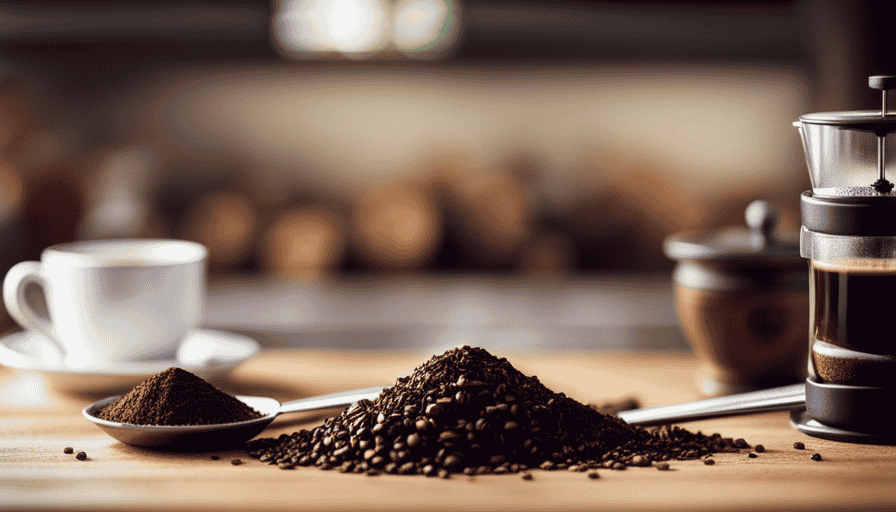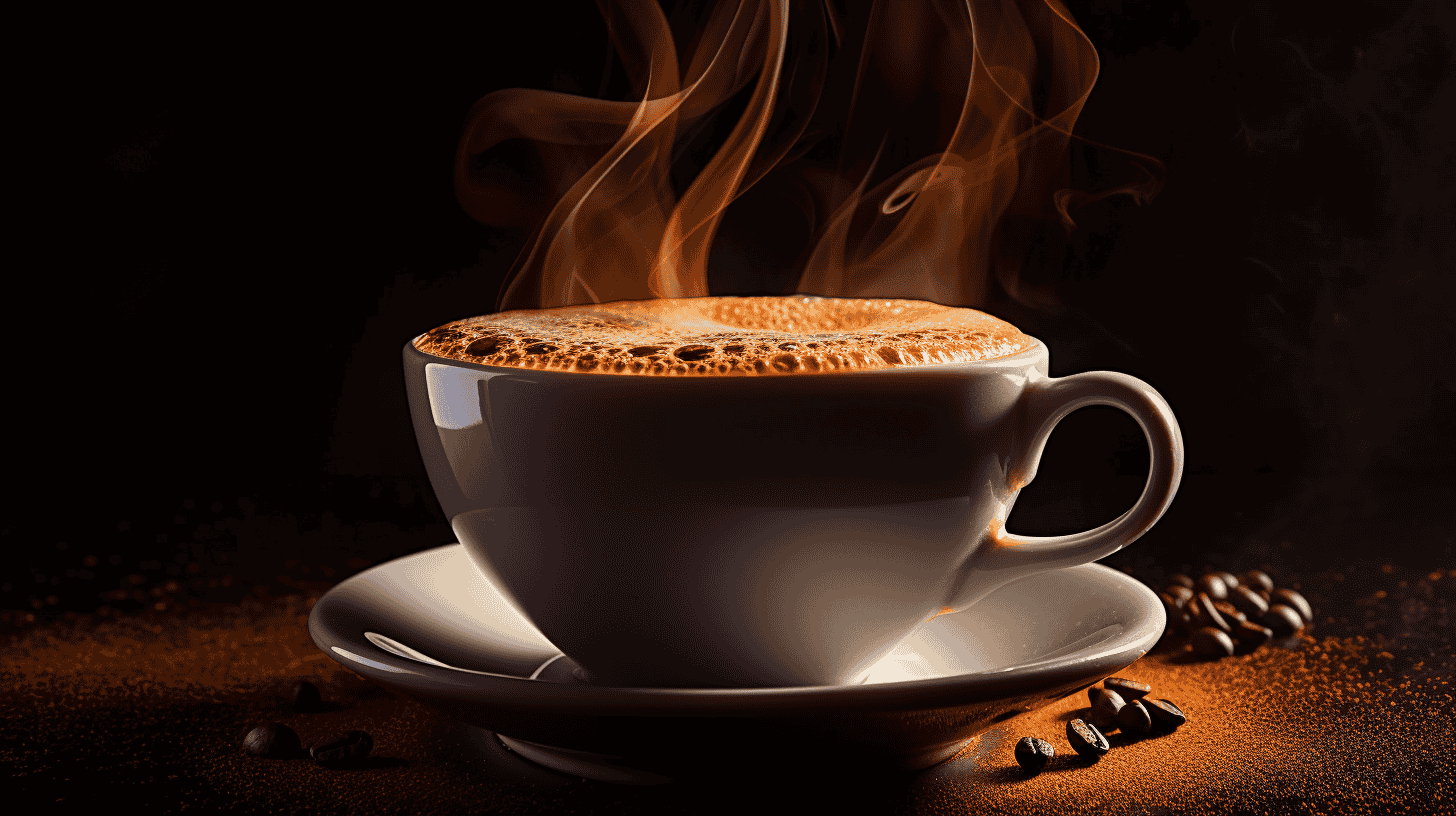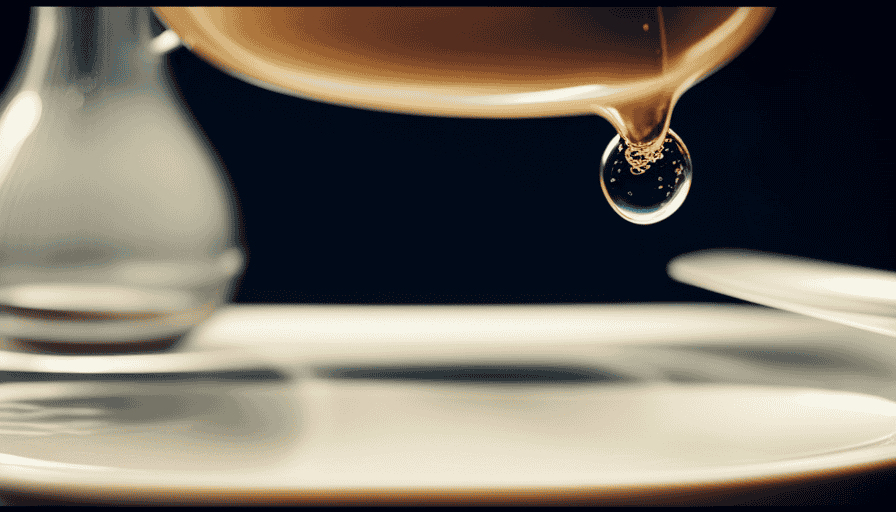Coffee Brewing Methods
The Ultimate Coffee Grind Size Guide For Perfect Brewing

Have you ever wondered why some cups of coffee taste better than others? The secret lies in the grind size. Achieving the perfect grind size is crucial for extracting the optimal flavors from your coffee beans.
In this comprehensive guide, we will delve into the world of coffee grinding, exploring the different grind sizes and their impact on the brewing process. From the coarse grind needed for a French press to the fine grind required for an espresso, we will unravel the mysteries of grind sizes and their effects on taste.
But it’s not just about the size of the grind; we will also explore the differences between blade grinders and burr grinders, and how they affect the quality of your coffee.
So, if you want to elevate your coffee brewing game and unlock the full potential of your beans, join us on this journey through the ultimate coffee grind size guide for perfect brewing.
Key Takeaways
- Grind size is crucial for optimal flavors in coffee brewing.
- Different brewing methods require specific grind sizes.
- Regularly cleaning and maintaining the coffee grinder is important for flavor and quality.
- Troubleshooting common issues can improve coffee quality, such as adjusting grind size and brewing time.
Grinding Basics
Grinding basics encompass the fundamental principles and techniques involved in achieving the optimal grind size for different brewing methods, as previously established in the pre-existing knowledge. To ensure the best brewing results, it is crucial to understand and implement proper grinding techniques.
One important aspect of grinding basics is grinder maintenance. Regularly cleaning and maintaining the coffee grinder helps to prevent the buildup of coffee oils and residue, which can impact the flavor and quality of the coffee. It is recommended to clean the grinder thoroughly at least once a month, depending on usage.
Additionally, adjusting the grind size based on the desired brewing method is essential for extracting the desired flavors from the coffee grounds.
Mastering these grinding basics will contribute to consistently excellent coffee brewing results.
Different Grind Sizes
Different brewing methods require specific grind sizes to achieve optimal flavor extraction. The grind size has a significant impact on the extraction process, as it determines the rate at which water extracts flavors from the coffee grounds. Adjusting the grind size allows for better control over the extraction, preventing under or over-extraction. For example, a coarse grind is ideal for a French Press, as it allows for a longer steeping time without over-extracting the coffee. On the other hand, an espresso requires a fine grind to ensure a shorter contact time and maximize flavor extraction. Other brewing methods such as pour over, Chemex, and Aeropress have their own recommended grind sizes. By understanding and adjusting the grind size according to the brewing method, coffee enthusiasts can unlock the full potential of their beans and enjoy a delicious cup of coffee.
| Brewing Method | Grind Size |
|---|---|
| French Press | Coarse |
| Espresso | Fine |
| Pour Over | Medium-fine |
| Chemex | Medium-coarse |
| Aeropress | Varies |
Tips for Better Brewing
To enhance the quality of your brewed coffee, it is essential to follow these expert tips.
Firstly, ensure that you are using the correct brewing techniques for your chosen method. Each brewing method requires a specific grind size to extract the optimal flavors from the coffee grounds.
Additionally, it is important to troubleshoot common issues that may arise during the brewing process. For example, if your coffee tastes bitter, it may be due to over-extraction caused by using a fine grind size or brewing for too long. On the other hand, if your coffee tastes weak, it may be due to under-extraction caused by using a coarse grind size or brewing for too short a time.
By understanding these brewing techniques and troubleshooting common issues, you can consistently achieve a perfect cup of coffee.
Frequently Asked Questions
Can I use the same grind size for all brewing methods?
Grind size plays a critical role in brewing coffee, affecting the extraction process and ultimately the flavor of the final cup. While it may be tempting to use the same grind size for all brewing methods, it is not recommended.
Adjusting the grind size for different beans and brewing methods is essential to achieve optimal results. Using pre-ground coffee may offer convenience, but it also has drawbacks such as loss of flavor and freshness.
Therefore, it is advisable to grind coffee beans fresh each day for maximum flavor.
How do I adjust the grind size for different coffee beans?
To adjust the grind size for different coffee beans, one must consider the impact of grind size on flavor. The grind size directly affects the extraction rate, which in turn affects the taste of the coffee. A finer grind size increases the surface area of the coffee particles, resulting in a faster extraction and a stronger flavor.
On the other hand, a coarser grind size slows down the extraction, resulting in a milder flavor. Experimenting with different grind sizes allows for customization and optimization of flavor profiles based on the specific characteristics of the coffee beans being used.
Can I use pre-ground coffee instead of grinding my own?
Using pre-ground coffee instead of grinding your own can have an impact on the flavor of your coffee.
Pre-ground coffee is convenient, especially for busy mornings when time is limited. However, grinding your own coffee beans allows for greater control over the grind size, which is crucial for extracting optimal flavor.
Pre-ground coffee may not be as fresh and may have a different grind size than what is needed for your specific brewing method. Therefore, grinding your own coffee beans is recommended for a better tasting cup of coffee.
How long does it take to grind coffee beans?
The time it takes to grind coffee beans can vary depending on several factors.
The grind size of the coffee beans, the type of grinder being used, and the desired consistency all play a role in determining the duration of the grinding process.
Factors such as blade speed, motor power, and the amount of coffee being ground can also impact the time required.
It is important to note that the grind size directly affects the extraction process, which is crucial for achieving the desired flavor in coffee.
Therefore, taking the time to grind coffee beans properly is essential for a perfect brew.
Can I use a blade grinder for espresso?
Blade grinders have limitations when it comes to espresso brewing. They typically produce inconsistent grind sizes, resulting in uneven extraction and a subpar espresso shot. A blade grinder’s high-speed spinning blades also generate heat, which can negatively affect the coffee’s flavor.
As an alternative, burr grinders are recommended for espresso brewing. Burr grinders offer more precision and control over grind size, resulting in a more even extraction and a better-tasting espresso.
Conclusion
In conclusion, the ultimate coffee grind size guide for perfect brewing serves as a metaphorical compass for coffee enthusiasts on their quest for the perfect cup.
By emphasizing the importance of grinding and providing a comprehensive chart, the guide offers a roadmap to unlocking the full potential of coffee flavors.
It symbolizes the attention to detail and precision required in the art of brewing.
With its insightful tips and recommendations, this guide empowers readers to elevate their coffee experience and savor the richness and complexity that fresh, properly ground beans can offer.
Noah, the Editor-in-Chief at Cappuccino Oracle, plays a pivotal role in shaping the voice and vision of our renowned platform. With an unwavering passion for coffee, coffee alternatives, and tea, Noah leads Cappuccino Oracle towards new horizons in the realm of coffee journalism.
Beyond his professional responsibilities, Noah serves as a mentor and guiding force for his team. His dedication to journalistic excellence and genuine love for coffee, coffee alternatives, and tea continue to inspire and motivate the Cappuccino Oracle family. In the ever-evolving world of these beverages, Noah’s leadership ensures that our platform remains at the forefront, delivering enlightening and enjoyable content to our readers worldwide.
Coffee Brewing Methods
What Is Coffee Powder? A Guide To Instant Coffee And Its Benefits

Instant coffee, also referred to as coffee powder, offers a quick and convenient solution for coffee lovers to savor their preferred drink. Its ease of preparation has made it a household essential for numerous coffee aficionados.
But what exactly is coffee powder and how is it made?
Coffee powder is made by roasting coffee beans, grinding them, brewing the coffee, and then removing the water to create a dissolvable powder. This process ensures that all the flavors and aromas of the coffee beans are captured in the powder, allowing for a rich and flavorful cup of coffee.

One interesting statistic to note is that coffee powder and ground coffee are not the same. Instant coffee has already undergone the entire coffee-making process, making it different from ground coffee.
In addition to its convenience, coffee powder also provides the same nutrients as a standard cup of coffee. However, it is important to consume it in moderation as it contains caffeine. Reading nutrition labels and checking caffeine quantities is essential to avoid unintentional overdosing.
In this article, we will delve deeper into the world of coffee powder, exploring its production process, caffeine content, and safety considerations. So grab a cup of coffee, sit back, and let’s explore the wonders of coffee powder together.
Key Takeaways
- Coffee powder, also known as instant coffee, is a convenient way to enjoy coffee.
- It is important to consume coffee powder in moderation due to its caffeine content.
- Coffee powder provides the same nutrients as a standard cup of coffee.
- Coffee powder production has environmental impacts, but efforts are being made to reduce them through sustainable practices and technologies.
What is it?
Coffee powder, also known as instant coffee, is a soluble form of coffee made by roasting, grinding, brewing, and dehydrating coffee beans. This process results in a dissolvable powder that can be consumed as a beverage or used in cooking.
There are different types of coffee powders available, with varying flavors and strengths to suit individual preferences. One of the main advantages of coffee powder is its convenience and ease of use. It can be quickly dissolved in hot water, eliminating the need for brewing equipment or waiting for a pot of coffee to brew.
Additionally, coffee powder offers several health benefits. It contains antioxidants that help protect cells from damage, and it has been associated with a reduced risk of various diseases, including type 2 diabetes, Parkinson’s disease, and liver cancer. However, it is important to consume coffee powder in moderation, as it can also have negative effects on sleep, anxiety, and digestive health.
How it’s Made
To produce coffee powder, coffee beans are first roasted, then ground, brewed, and finally dehydrated through either spray-drying or freeze-drying methods.
-
Spray-drying involves spraying a liquid coffee extract into a hot chamber, where the water evaporates, leaving behind dried coffee particles.
-
Freeze-drying, on the other hand, involves freezing the brewed coffee and then placing it in a vacuum chamber. The frozen water in the coffee sublimates, turning directly into vapor and leaving behind freeze-dried coffee particles.
Pros and cons of these manufacturing methods include:
-
Spray-drying is a faster and more cost-effective process, but it can result in a loss of flavor and aroma due to the high heat involved.
-
Freeze-drying preserves the flavor and aroma better, but it is a slower and more expensive process.
The environmental impact of coffee powder production includes energy consumption, water usage, and waste generation from the manufacturing processes. Efforts are being made to reduce these impacts through sustainable practices and technologies.
Caffeine Content and Safety
The caffeine content in coffee powder should be taken into consideration to ensure safe consumption. Different coffee brands may vary in their caffeine content, and it is important to be aware of the levels present in the product.
Consuming excessive amounts of caffeine can have various health effects. While caffeine can provide temporary alertness and improved cognitive function, excessive consumption can lead to negative side effects such as restlessness, insomnia, increased heart rate, and even anxiety. It is essential to be mindful of one’s caffeine intake, as exceeding the recommended daily limit can have adverse effects on health.
Therefore, it is advisable to check the caffeine quantities mentioned on the packaging of coffee powder and other coffee-related products to avoid unintentional overdosing. Moderation is key when it comes to consuming caffeine-rich beverages.
Frequently Asked Questions
How long does coffee powder last after it has been opened?
The shelf life of opened coffee powder depends on several factors, including storage conditions and the type of packaging. Generally, coffee powder can last for several months to a year after it has been opened.
To extend its shelf life, it is important to store it in an airtight container in a cool, dark place away from moisture and heat. Following these storage tips can help maintain the flavor and freshness of the coffee powder for a longer period of time.
Can coffee powder be used to make espresso?
Coffee powder can be used as an alternative to espresso, but it may not provide the same depth and intensity of flavor. When choosing a coffee powder for espresso, it is important to consider the roast level and grind size. Darker roasts and finer grinds tend to produce a more espresso-like flavor. However, it is important to note that instant coffee may not be able to replicate the crema and richness that is characteristic of a true espresso shot.
Is coffee powder suitable for people with acid reflux or sensitive stomachs?
For individuals with acid reflux or sensitive stomachs, coffee powder may not be the best option. However, there are coffee powder alternatives that are considered to be more suitable.
One interesting statistic is that low acid coffee, such as those made from beans processed with the Swiss Water Method, can have up to 70% less acid compared to regular coffee.
These alternatives provide a milder and less irritating option for individuals with acid reflux or sensitive stomachs.
Can coffee powder be used in baking recipes?
Coffee powder can indeed be used in baking recipes to add a rich coffee flavor to desserts. It is important to note that coffee powder is different from instant coffee. Instant coffee is already brewed and dehydrated, while coffee powder is simply the powdered form of ground coffee beans.
When using coffee powder in baking, it can be dissolved in a small amount of hot water before adding it to the recipe. This will ensure that the coffee flavor is evenly distributed throughout the dessert.
So, coffee powder can be a great addition to various desserts, such as cakes, cookies, and brownies, to enhance their taste with a hint of coffee.
Does coffee powder have the same antioxidant benefits as freshly brewed coffee?
Coffee powder, also known as instant coffee, contains a similar antioxidant content as freshly brewed coffee. Antioxidants are compounds that help protect against oxidative stress and reduce the risk of chronic diseases.
Instant coffee is made from roasted coffee beans, ground, brewed, and then dehydrated to form a powder. While the drying process may slightly reduce the antioxidant levels compared to freshly brewed coffee, instant coffee still provides health benefits associated with antioxidants.
Conclusion
In conclusion, coffee powder, also known as instant coffee, is a convenient and popular option for coffee lovers. It is made through a process of roasting, grinding, brewing, and drying coffee beans.
This dissolvable powder offers the same nutrients as a standard cup of coffee and can be consumed by dissolving it in hot water or incorporating it into recipes. However, it is crucial to be mindful of the caffeine content and consume it in moderation.
An interesting statistic to note is that coffee is the second most traded commodity in the world, after oil, highlighting its global popularity and significance.
Noah, the Editor-in-Chief at Cappuccino Oracle, plays a pivotal role in shaping the voice and vision of our renowned platform. With an unwavering passion for coffee, coffee alternatives, and tea, Noah leads Cappuccino Oracle towards new horizons in the realm of coffee journalism.
Beyond his professional responsibilities, Noah serves as a mentor and guiding force for his team. His dedication to journalistic excellence and genuine love for coffee, coffee alternatives, and tea continue to inspire and motivate the Cappuccino Oracle family. In the ever-evolving world of these beverages, Noah’s leadership ensures that our platform remains at the forefront, delivering enlightening and enjoyable content to our readers worldwide.
Coffee Brewing Methods
The Art Of Cold Brew: Mastering The Perfect Ratio

Cold brew coffee has gained immense popularity for its velvety flavor and invigorating effects. It is essential to attain the ideal balance of coffee and water for achieving the desired taste.
The general consensus for cold brew is a 1:5 ratio, but experimentation is encouraged to find the preferred taste. Properly soaking coarsely ground coffee beans is essential for extracting the flavors.
It is advisable to only make what will be consumed to avoid waste, as cold brew can last up to a week in the refrigerator. Surprisingly, cold brew can be stronger than hot coffee, depending on the ratio used. Dilution with water or ice is unnecessary, as it is already factored into the drink.
Personal preference plays a significant role in determining the strength of cold brew, and the taste can be adjusted through dilution or mixing with other ingredients such as sweetened milk or liquid sugar.
With the knowledge of cold brew ratios, one can craft the perfect cup of cold brew and customize its strength according to their liking.
Key Takeaways
- The proportion of coffee to water is crucial in making cold brew.
- The general consensus for cold brew is a 1:5 proportion of coffee to water.
- Experimentation with ratios is encouraged to find the preferred taste.
- Properly soaking the coarsely ground coffee beans is important.
What is Cold Brew?
Cold brew is a method of coffee extraction that involves steeping coarsely ground coffee beans in cold water for an extended period of time, resulting in a smooth, low-acid coffee concentrate.
Unlike iced coffee, which is brewed with hot water and then cooled down, cold brew is made by using only cold water throughout the entire brewing process.
This slow extraction method enhances the flavor profile of the coffee, resulting in a beverage that is less bitter and acidic compared to traditional brewing methods.
Additionally, cold brew offers health benefits such as reduced acidity, which can be beneficial for individuals with sensitive stomachs.
The lower acidity also makes cold brew a more teeth-friendly option, as it is less likely to cause enamel erosion.
Ratio Importance
The key to achieving the ideal taste in cold brew lies in finding the precise balance between the amount of coffee and water used, as this proportion directly impacts the flavor profile and strength of the final product, analogous to the delicate interplay of notes in a symphony.
Exploring different ratios allows for customization and experimentation, enabling cold brew enthusiasts to find the perfect balance that suits their taste preferences. While the general consensus for cold brew is a 1:5 ratio of coffee to water, personal preference plays a significant role in determining the preferred strength.
Dilution with additional water or ice is not necessary, as it is already factored into the drink. It is essential to properly soak the coarsely ground coffee beans to extract the desired flavors and avoid any bitterness.
By mastering the art of finding the perfect ratio, one can craft a cold brew that is both smooth and invigorating.
Tips for Brewing
To achieve optimal results when brewing cold brew coffee, it is beneficial to follow a few helpful tips.
Firstly, ensure that you are using the correct coffee to water ratio. The general consensus for cold brew is a 1:5 proportion of coffee to water, but feel free to adjust this ratio to suit your personal taste preferences.
Additionally, choose high-quality, freshly-ground coffee beans for maximum flavor extraction. Coarsely ground beans work best for cold brew, as they allow for a slower extraction process.
When soaking the coffee grounds, make sure they are fully submerged in water and stir gently to ensure even saturation.
Steep the mixture in the refrigerator for at least 12 hours, or up to 24 hours for a stronger brew.
Finally, strain the mixture through a fine mesh sieve or a coffee filter to remove any sediment.
By following these tips, you can maximize the flavor and enjoyment of your cold brew coffee.
Frequently Asked Questions
Can I use any type of coffee to make cold brew, or are there specific types that work better?
While any type of coffee can be used to make cold brew, certain coffee bean varieties work better due to their flavor profiles. Different coffee bean varieties can result in varying taste profiles, acidity levels, and strength in cold brew.
Some popular choices for cold brew include medium to dark roast beans, which tend to have a richer and bolder flavor. Additionally, brewing methods such as immersion or slow drip can also impact the taste and strength of the cold brew.
How long should I steep the coffee beans in water to achieve the desired strength of cold brew?
The steeping time for cold brew and the best coffee beans to use are important factors in achieving the desired strength of cold brew.
The duration of steeping the coffee beans in water varies depending on personal preference. Generally, a steeping time of 12-24 hours is recommended for a strong and flavorful cold brew. However, some individuals prefer a longer steeping time of up to 48 hours for a bolder taste.
It is important to choose coffee beans specifically labeled for cold brew as they are coarsely ground and have the ideal flavor profile for this brewing method.
Can I make cold brew in larger batches and store it for longer than a week in the refrigerator?
In the realm of cold brew coffee, the quest for the perfect ratio is akin to an artist striving for their masterpiece.
When it comes to storing larger batches of cold brew for an extended period in the refrigerator, caution must be exercised.
While cold brew can be made in larger quantities, it is recommended to consume it within a week for optimal freshness. Prolonged refrigeration may result in a decline in taste and quality.
Therefore, it is best to craft smaller batches to savor the true essence of cold brew.
Is it necessary to use coarsely ground coffee beans for cold brew, or can I use a different grind size?
Different grind sizes for cold brew can affect the quality and taste of the final product. While it is not necessary to use coarsely ground coffee beans for cold brew, it is highly recommended. Coarsely ground coffee allows for a slower extraction process, resulting in a smoother and less bitter brew.
Finely ground coffee can lead to over-extraction and a more acidic taste. Therefore, using coarsely ground coffee beans provides the benefits of a better flavor profile and a more enjoyable cold brew experience.
Can I use hot water instead of cold water to make cold brew, or will it affect the taste?
Using hot water for cold brew: pros and cons
The temperature of the water significantly affects the extraction process and flavor of cold brew.
Using hot water for cold brew has both pros and cons. Hot water can extract flavors more quickly, resulting in a shorter brewing time. However, it can also lead to over-extraction, resulting in a bitter taste.
Cold water, on the other hand, allows for a slower extraction process, resulting in a smoother and less acidic flavor.
Therefore, using hot water for cold brew can alter the taste and may not achieve the desired flavor profile.
Noah, the Editor-in-Chief at Cappuccino Oracle, plays a pivotal role in shaping the voice and vision of our renowned platform. With an unwavering passion for coffee, coffee alternatives, and tea, Noah leads Cappuccino Oracle towards new horizons in the realm of coffee journalism.
Beyond his professional responsibilities, Noah serves as a mentor and guiding force for his team. His dedication to journalistic excellence and genuine love for coffee, coffee alternatives, and tea continue to inspire and motivate the Cappuccino Oracle family. In the ever-evolving world of these beverages, Noah’s leadership ensures that our platform remains at the forefront, delivering enlightening and enjoyable content to our readers worldwide.
Coffee Brewing Methods
The Art Of Brewing Perfect Espresso At Home

In the quest for the ultimate espresso, there exists an artistic skill that goes beyond the routine task of preparing coffee. It is a careful procedure that requires constant focus on every detail, a steadfast dedication to maintaining consistency, and an unbreakable passion for the trade.
Brewing the perfect espresso at home is not for the faint of heart; it requires a deep understanding of the essential steps, the right techniques, and the precise measurements. Like a virtuoso composing a symphony, the home barista must master the delicate dance of grinding and tamping, the intricate art of milk steaming, and the artful balance of flavors.
With each sip, a harmonious symphony of taste unfolds, awakening the senses and transporting the drinker to a realm of pure bliss. Join us on this journey as we unlock the secrets of the art of brewing perfect espresso at home, and embark on a quest to elevate your coffee experience to new heights.
Key Takeaways
- Pursuit of perfect espresso requires art, attention to detail, consistency, and dedication.
- Brewing perfect espresso at home requires understanding essential steps, techniques, and measurements.
- Home baristas must master grinding, tamping, milk steaming, and flavor balance.
- The key to brewing a perfect espresso lies in the harmonious symphony of taste achieved through essential steps such as setting the grinder, using the right amount of ground coffee, tamping evenly, timing the shot, and adjusting based on taste indicators.
Essential Steps
The essential steps in brewing perfect espresso at home include:
- Setting the grinder to a fine grind size
- Using around 20 grams of ground coffee in the portafilter
- Evenly and firmly tamping the grounds
- Timing the shot to hit 60 ml in 20-30 seconds
- Adjusting the grind size and extraction based on taste indicators such as sourness or bitterness
Preheating equipment, such as the espresso maker, is also crucial to ensure consistent results. Additionally, the dialing in process, which involves adjusting the grind size and extraction time, may need to be repeated when switching between different coffee roasts.
By following these steps and techniques, coffee enthusiasts can achieve the perfect balance of flavors and aromas in their homemade espresso.
Grinding and Tamping
Grinding and tamping are essential steps in the espresso-making process. The grind size selection plays a crucial role in determining the quality of the extraction. A fine grind size is typically preferred for espresso, as it allows for a slower extraction and enhances the flavors. However, finding the perfect grind size may require some experimentation and adjustments to achieve the desired taste profile.
Tamping, on the other hand, involves evenly pressing the ground coffee in the portafilter with the right amount of pressure. This step ensures that water passes through the coffee evenly during extraction, avoiding channeling and promoting consistent extraction. Tamping straight and level is important to prevent any inconsistencies in the extraction process.
By mastering the art of grinding and tamping, one can achieve a superior espresso shot with optimal flavor and aroma.
Milk Steaming Techniques
Milk steaming techniques play a crucial role in achieving the desired consistency and temperature for milk-based espresso drinks.
The temperature of the milk is a key factor in creating a creamy and velvety texture, while the frothing techniques determine the amount and quality of foam.
A common technique is to position the steam wand just below the surface of the milk, creating a whirlpool effect to incorporate air and create microfoam.
The aim is to achieve a temperature of around 150°F (65°C) and a smooth, glossy texture.
It is important to practice and experiment with different techniques to find the perfect balance between heating the milk and creating the desired amount of foam.
With consistent practice and attention to detail, mastering milk steaming techniques will enhance the overall espresso experience.
Frequently Asked Questions
What is the ideal water temperature for brewing espresso at home?
The ideal water temperature for brewing espresso at home is between 195°F and 205°F (90°C and 96°C). This temperature range is crucial in extracting the flavors and aromas from the coffee beans.
Additionally, it ensures that the espresso shot is not under-extracted or over-extracted, resulting in a balanced and flavorful cup of coffee.
Using freshly roasted coffee beans is also essential as they possess more volatile compounds that contribute to the rich and complex flavors in the espresso shot.
Can I use pre-ground coffee for brewing espresso?
Using pre-ground coffee for brewing espresso can be done, but it may not produce the best results. The key to achieving a high-quality espresso lies in the freshness of the coffee grounds. Pre-ground coffee tends to lose its flavor and aroma over time, resulting in a less satisfying espresso.
To truly experience the nuances and complexity of espresso, it is recommended to invest in a good espresso machine and follow a step-by-step espresso brewing guide. This will ensure that you have control over the grind size, dosage, and extraction time, allowing you to achieve the perfect espresso shot.
How often should I clean my espresso machine?
Regularly cleaning and descaling your espresso machine is of utmost importance. Neglecting this essential task will result in subpar espresso and potential damage to your machine.
To maintain optimal performance, deep clean your espresso machine at least once a month. Use a mixture of water and vinegar or a commercial descaling solution to remove mineral buildup.
Additionally, regularly clean removable parts such as the portafilter, steam wand, and drip tray to prevent the buildup of coffee residue and ensure a consistently delicious brew.
What is the recommended ratio of coffee to water for brewing espresso?
The recommended ratio of coffee to water for brewing espresso is around 20 grams of ground coffee to produce 60 ml of espresso shot within 20-30 seconds.
To achieve the perfect extraction time, it is crucial to set the grinder to a fine grind size and tamp the grounds evenly and with pressure. This ensures consistent extraction and avoids under or over-extraction.
Adjusting the grind size may be necessary to fine-tune the extraction process.
Are there any alternative milk options for steaming and frothing?
Alternative milk options for steaming and frothing can be used to achieve the perfect microfoam for latte art.
Non-dairy milk options such as almond milk, soy milk, oat milk, and coconut milk offer alternatives for those who are lactose intolerant or prefer plant-based options.
These alternatives can produce a creamy and frothy texture similar to dairy milk when steamed properly.
Experimenting with different milk options and techniques is crucial to achieving the desired results in latte art with non-dairy milk.
Noah, the Editor-in-Chief at Cappuccino Oracle, plays a pivotal role in shaping the voice and vision of our renowned platform. With an unwavering passion for coffee, coffee alternatives, and tea, Noah leads Cappuccino Oracle towards new horizons in the realm of coffee journalism.
Beyond his professional responsibilities, Noah serves as a mentor and guiding force for his team. His dedication to journalistic excellence and genuine love for coffee, coffee alternatives, and tea continue to inspire and motivate the Cappuccino Oracle family. In the ever-evolving world of these beverages, Noah’s leadership ensures that our platform remains at the forefront, delivering enlightening and enjoyable content to our readers worldwide.
-

 Coffee Alternatives And Tea4 weeks ago
Coffee Alternatives And Tea4 weeks agoThe Coffee Alternative That’s Helping People Live to 100
-

 Coffee Alternatives And Tea2 weeks ago
Coffee Alternatives And Tea2 weeks agoNutritionists Are Raving About This Coffee Alternative – Here’s Why
-

 Coffee, Tea and Alternatives and Health plus Fitness2 weeks ago
Coffee, Tea and Alternatives and Health plus Fitness2 weeks agoThe Shocking Reason Health Experts Are Abandoning Green Tea
-

 Coffee Alternatives And Tea2 weeks ago
Coffee Alternatives And Tea2 weeks agoThe ‘Miracle Tea’ That’s Helping People Sleep Better Than Ever
-

 Coffee Alternatives And Tea2 weeks ago
Coffee Alternatives And Tea2 weeks agoThis Coffee Substitute Promises to Double Your Productivity
-

 Coffee Alternatives And Tea2 weeks ago
Coffee Alternatives And Tea2 weeks agoThe Tea That’s So Good, It’s Causing Shortages Worldwide
-

 Coffee Alternatives And Tea1 week ago
Coffee Alternatives And Tea1 week agoThe ‘Super Brew’ That’s Making Energy Drinks Look Like Soda
-

 Coffee Alternatives And Tea1 week ago
Coffee Alternatives And Tea1 week agoThe Tea That Claims to Reverse Aging – Is It Too Good to Be True?



























